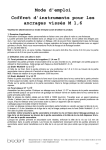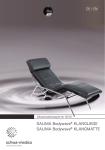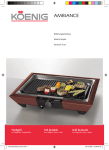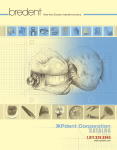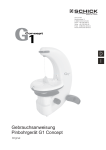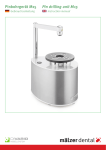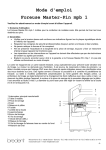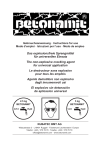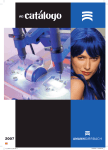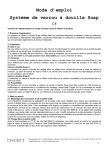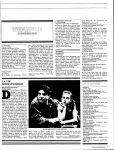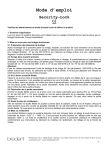Download Master-Pin-System Systéme Master Pin Master-Pin-System
Transcript
Gebrauchsanweisung Master-Pin-System D Bitte diese Gebrauchsanweisung vor dem Produkteinsatz ausführlich lesen. 1. Einsatzbereich Das Master-Pin-System (Master-Pin (Messing) und Master-Pin Hülse (Kunststoff)) wird zur präzisen Repositionierung von gesägten Einzelstümpfen auf dem Modellsockel des Sägeschnittmodells verwendet. 2. Verarbeitung 2.1 Zahnkranzvorbereitung Den für die Pinlöcher zu bohrenden Zahnkranz plan beschleifen. Besonders geeignet ist hierfür ein Gipstrimmer mit Diamantschleifscheibe. Die getrimmte Basis des Zahnkranzes kann mit Nassschleifpapier (Körnung 600) optimiert werden. Den Zahnkranz gut trocknen lassen, da der Gips sonst beim Fräsen und Bohren schmiert. Vor dem Bohren und Setzen der Master-Pins in den Zahnkranz, diesen an seiner lingualen bzw. palatinalen Innenseite leicht konisch (6°) zur Basis hin beschleifen. Dies erleichtert einerseits das spätere Abheben des Zahnkranzes vom Modellsockel und dient andererseits als zusätzliche Verschlüsselung bzw. Verdrehschutz der einzelnen Stümpfe auf dem Modellsockel. 2.2 Bohrer Je nach Pin-Bohrgerät kann es sein, dass der Bohrlochdurchmesser durch Ungenauigkeiten der Spannzange variiert. Aus diesem Grund gibt es für das Master-Pin-System drei verschiedene Pinbohrer. 2.2.1 Master-Pin-Diatithartmetallstufenbohrer Standard/grün ø 1,5/2 mm In dem Sortiment Master-Pin ist der Master-Pin-Diatithartmetallstufenbohrer Standard/grün ø 1,5/2 enthalten. In den meisten Fällen bohrt der Master-Pin-Diatithartmetallstufenbohrer Standard/grün ø 1,5/2 exakte Bohrlöcher für die Aufnahme der Master-Pins. 2.2.2 Master-Pin-Diatithartmetallstufenbohrer Spezial/gelb ø 1,5/2 mm Sollten auf Grund der Rundlaufgenauigkeit des Pinbohrgerätes die Master-Pins zu schwer in den Zahnkranz einsteckbar sein, so kann der mit einem größeren Durchmesser (+ 0,01 mm) erhältliche Master-Pin-Diatithartmetallstufenbohrer Spezial/gelb ø 1,5/2 verwendet werden. Dieser Bohrer bohrt ein größeres Loch, wodurch sich die Master-Pins leichter einstecken und einkleben lassen. 2.2.3 Master-Pin-Diatithartmetallstufenbohrer Spezial/rot ø 1,5/2 mm Sind die Bohrlöcher im Zahnkranz auf Grund der Rundlaufungenauigkeit des Pinbohrgerätes mit dem Master-PinDiatithartmetallstufenbohrer Standard/grün ø 1,5/2 zu groß - der Master-Pin wackelt im Bohrloch, kann der mit einem kleineren Durchmesser (- 0,01 mm) erhältliche Master-Pin-Diatithartmetallstufenbohrer Spezial/rot ø 1,5/2 verwendet werden. Dieser Bohrer bohrt ein kleineres Loch. 2.3 Bohren der Pinlöcher Grundlage ist eine korrekte Einstellung des Master-Pin-Diatithartmetallstufenbohrers Standard/grün ø 1,5/2 mm (Best.-Nr. 360 0119 2) im Pinbohrgerät. Empfehlung: Trockene Zahnkränze vor dem Bohren mit der Basalseite kurz auf ein nasses Tuch stellen. Anschließend trockenblasen und sofort mit dem Pinbohrgerät die Bohrlöcher lagerichtig bohren. Dadurch wird ein Ausbrechen des Gipses um die Bohrlöcher verhindert – es entstehen Präzisionsbohrungen. Die Bohrbegrenzungslinie muss am Master-Pin mit dem Zahnkranz abschließen, um die exakte Bohrtiefe zu erhalten. Wir empfehlen je Stumpf zwei Bohrungen zu setzen: 1. Bohrung = Zentralfissur, 2. Bohrung = 2 bis 3 mm entfernt nach lingual bzw. palatinal. 2.4 Einkleben des Master-Pins Einen Tropfen Sekundenkleber auf eine geeignete Unterlage (z. B. Wachsplatte) geben. Das Eintupfen des Master-Pins in den Sekundenkleber soll nur oberflächlich an der Stirnseite des Klebeschafts erfolgen. Den Master-Pin rechtwinklig zur Zahnkranzbasis bis zum Anschlag in das Bohrloch setzen. 2.5 Isolieren Nach dem Einkleben der Master-Pins den Zahnkranz mit Gips-Gips-Isolierung Master-Sep (Best.-Nr. 520 0029 0) einpinseln. 2.6 Aufschieben der Master-Pin-Hülsen Die Master-Pin-Hülsen mit dem Retentionswulst zuerst so auf die Master-Pins aufschieben, damit diese exakt mit der Zahnkranzbasis abschließen. Sollten zwei Master-Pins sehr eng gesetzt sein, werden die beiden Master-Pin-Hülsen mit ihrer abgeflachten Seite zueinander aufgeschoben. 2.7 Sockeln Mit flüssigem Sockelgips und z. B. mit Master-Split-System (Best.-Nr. 360 0124 M) mehrere Zahnkränze zügig und blasenfrei sockeln. Da die Master-Pin-Hülsen die Master-Pins um 0,5 mm überragen, wird eine gleichmäßig definierte Höhe des Modellsockels erreicht. Alle Master-Pin-Hülsen sind an der Modellbasis sichtbar. Weissenhorner Str. 2 · 89250 Senden · Germany Tel. (+49) 0 73 09 / 8 72-22 · Fax (+49) 0 73 09 / 8 72-24 www.bredent.com · e-mail [email protected] 2.8 Trimmen Das Modell abschließend seitlich trimmen, dadurch läßt sich der Zahnkranz sehr einfach vom Modellsockel abziehen.3. Sicherheitsratschläge und Gefahrenhinweise Bei Arbeiten mit dem Pinbohrgerät sind die Sicherheitsratschläge und Gefahrenhinweise des jeweiligen Herstellers zu beachten, das gleiche gilt beim Umgang mit Sekundenkleber. 4. Lagerung und Haltbarkeit Das Master-Pin-System ist trocken bei Raumtemperatur aufzubewahren. 2.7 Preparing the base Prepare several arches using liquid plaster and e.g. the Master-Split system (Order No. 360 0124 M) without the formation of bubbles. Since the Master-Pin sleeves are 0.5 mm higher than the Master-Pins, a uniform, defined height is achieved. All Master-Pin sleeves can be seen at the model base. 2.8 Trimming Finally, trim the sides of the model to ensure that the arch can be easily removed from the model base. 5. Sonstige Hinweise Die Angaben dieser Gebrauchsanweisung werden stets den aktuellsten Ergebnissen und Erfahrungen angepasst. Wir empfehlen daher, vor Gebrauch einer neuen Packung, die Gebrauchsanweisung zu lesen. Diese Gebrauchsanweisung bezieht sich auf Master-Pin-System Best.-Nr. 360 0122 6, 360 0122 5 und 360 0119 2. 3. Safety recommendations and hazard warnings When working with the pin drilling unit, the safety recommendations and hazard warnings of the respective manufacturer must be observed; the same applies to handling of the cyanoacrylate adhesive (super glue). Instructions for use 5. Other information The information contained in these instructions for use is always updated according to the latest knowledge and experience. Therefore we recommend to read the instructions for use again before using a new package. These instructions for use refer to Master-Pin system, Order No. 360 0122 6, 360 0122 5 and 360 0119 2. Master-Pin-System Before using the product, please read these instructions for carfelluy use. GB 1. Indication range The Master-Pin system, Master-Pin (brass) and Master-Pin sleeve (plastic), is used for exact repositioning of sawed individual dies on the model base of the sawcut model. 2. Processing 2.1 Preparation of the arch The arch into which the holes for the pins are to be drilled must be ground flat. A plaster trimmer with diamond trimming wheel is perfectly suitable for this purpose. The trimmed base of the arch can be optimized with wet sanding paper (e.g. grain size 600). Let the arch dry well to avoid smearing of the plaster during milling and drilling. Prior to drilling and placing the Master-Pins in the arch, grind the the lingual resp. palatal inner side of the arch slightly conical (6°) towards the base. This will simplify subsequent removal of the arch from the model base and also serves to firmly position the individual dies on the model base and protect them against torsion. 2.2 Drills Depending on the pin drilling unit the diamater of the drill hole may vary due to imprecisions of the collect chuck. Therefore three different pin drills are available for the Master-Pin system. 2.2.1 Master-Pin Diatit tungsten carbide step drill standard/green ø 1.5/2 mm The Master-Pin assortment includes the Master-Pin Diatit tungsten carbide step drill standard/green ø 1.5/2. In most cases, the Master-Pin Diatit tungsten carbide step drill ø 1.5/2 will drill precise drill holes to receive the Master-Pins. 2.2.2 Master-Pin Diatit tungsten carbide drill special/yellow ø 1.5/2 mm If it is difficult to insert the pins into the arch due to the concentricity tolerance of the pin drilling unit, the MasterPin Diatit tungsten carbide step drill special/yellow ø 1.5/2 which features a larger diameter (+ 0.01 mm) can be used. This drill will prepare a larger drill hole so that the Master-Pins can be inserted and glued in more easily. 2.2.3 Master-Pin Diatit tungsten carbide step drill special/red ø 1.5/2 mm If the drill holes in the arch are too large due to the concentricity tolerance of the pin drilling unit with the MasterPin Diatit tungsten carbide step drill standard/green ø 1.5/2 – the Master-Pin does not have a stable, fixed position in the drill hole – the Master-Pin Diatit tungsten carbide step drill special/red ø 1.5/2 which features a smaller diameter (- 0,01 mm) can be used. This drill will prepare a smaller drill hole. 2.3 Drilling the pin holes Precondition for this work is the correct adjustment of the Master-Pin Diatit tungsten carbide step drill standard / green ø 1.5/2 mm (Order No. 360 0119 2) in the pin drill unit. Recommendation: Prior to drilling, place dry arches shortly on a wet cloth with the basal side facing downward. Then blow them dry and drill the drill holes (correct position must be ensured) immediately using the pin drillingl unit. Breaking out of plaster around the drill holes will be avoided – precise drill holes are obtained. The boundary line for drilling at the Master-Pin must be flush with the surface of the arch to receive the exact drilling depth. We recommend to prepare two drill holes for each die: 1. Drill hole = central fissure; 2. Drill hole = at a distance of 2 to 3 mm toward the lingual resp. palatal area. 2.4 Glueing in the Master-Pin Add a drop of cyanoacrylate adhesive (super glue) onto a suitable object (e.g. wax plate). Only the surface of the face of the glueing shaft of the Master-Pin is dipped in the cyanoacrylate adhesive. The Master-Pin is inserted up to the stop into the drill hole at a right angle towards the base of the arch. 2.5 Separating After glueing in the Master-Pins, apply Master-Sep (Order No. 520 0029 0) plaster/plaster separating liquid onto the die using a brush. 2.6 Sliding on the Master-Pin sleeves Slide the Master-Pin sleeves onto the Master-Pins so that they are seated flush with the base of the arch. Should two master pins be positioned very closely to each other, the two Master-Pin sleeves are slid on with the flattened sides facing each other. 4. Storage and durability The Master-Pin system must be stored at room temperature under dry conditions. Mode d’emploi Systéme Master Pin F Veuillez lire attentivement ce mode d’emploi avant d’utiliser le produit. 1. Champ d’application Le système Master-Pin se compose d’un pin en laiton et d’une gaine en plastique. Il permet de positionner les dies avec précision sur le modèle scié. 2. Mise en oeuvre 2.1 Préparation de l’arcade Bien meuler l’arcade à forer. Un taille-plâtre avec un disque diamanté est idéal. Pour la finition de la base du modèle, du papier de verre humide (Grain 600) conviendra parfaitement. Bien laisser sécher l’arcade afin d’éviter tout encrassement du modèle lors des travaux de forage et de fraisage. Avant le forage et la mise en place des Master-Pins, meuler le pourtour interne de l’arcade - face linguale ou palatine - en lui donnant un profil légèrement conique (6°) en direction de la base. Il sera ainsi plus facile de retirer l’arcade du modèle et les dies seront mieux ancrés dans le socle. 2.2 Forets En fonction de la foreuse utilisée, il est possible que le diamètre des trous forés varie à cause d’un manque de précision de la pince de serrage. C’est pourquoi, il existe pour le système Master-Pin trois forets différents. 2.2.1 Foret à épaulement en carbure de tungstène Diatit-Master-Pin standard/vert ∅ 1,5/2 mm C’est ce foret qui est livré avec le coffret Master-Pin. La plupart du temps, le foret à épaulement en carbure de tungstène Diatit-Master-Pin standard/vert ∅ 1,5/2 mm perce des trous précis, adaptés aux Master-Pins. 2.2.2 Foret à épaulement en carbure de tungstène Diatit-Master-Pin spécial /jaune ∅ 1,5/2 mm Si pour des raisons de concentricité de la foreuse, les Master-Pins sont difficiles à insérer dans l’arcade, il faudra alors utiliser le foret à épaulement en carbure de tungstène Diatit-Master-Pin spécial/jaune ∅ 1,5/2 mm présentant un diamètre plus large (+ 0,01 mm). Ce foret perce un trou plus grand et les Master-Pins s’insèrent et se collent donc plus facilement. 2.2.3. Foret à épaulement en carbure de tungstène Diatit-Master-Pin spécial / rouge ∅ 1,5/2 mm Si pour des raisons de concentricité de la foreuse, les trous forés avec le foret à épaulement en carbure de tungstène Diatit-Master-Pin standard/vert ∅ 1,5/2 mm sont trop larges et que les pins sont trop lâches dans les trous, il faudra alors utiliser le foret à épaulement en carbure de tungstène Diatit-Master-Pin spécial/rouge ∅ 1,5/2 mm présentant un diamètre plus petit (- 0,01 mm). Ce foret perce un trou plus petit. 2.3 Forage des trous Il est important au départ de monter correctement sur la foreuse le foret à épaulement en carbure de tungstène Diatit-Master-Pin standard/vert Æ 1,5/2 mm (N° de cde 360 0119 2). Conseil: déposer un instant les arcades sèches (par la base) sur un chiffon mouillé. Puis les sécher à la soufflette et forer tout de suite après les trous dans avec la foreuse. C’est une façon de prévenir toute fracture du plâtre autour des trous forés et de garantir la précision des forages. Les forages doivent s’arrêter au niveau des Master-Pins, c’est-à-dire coïncider avec l’arcade. Nous conseillons de pratiquer deux trous par pin: 1er trou = sillon central, 2ème trou = à 2/3 mm de distance en direction linguale ou palatine. 2.4 Collage des Master-Pins Déposer une goutte de colle instantanée sur un support adapté (par ex. une plaque de cire). Appliquer la colle sur le Master-Pin uniquement sur l’extrémité du mandrin. Insérer le Master-Pin perpendiculairement à la base de l’arcade jusqu’à ce qu’il vienne en butée dans le trou. 2.5 Isolation 2.8 Taille du modèle Pour finir, tailler les flancs du modèle ce qui vous permettra de retirer facilement l’arcade du socle. 4. Stockage Conserver le système Master-Pin à température ambiante. 5. Divers Les indications contenues dans ce mode d’emploi sont constamment révisées en fonction des dernières connaissances et expériences acquises. Nous vous conseillons donc de relire le mode d’emploi avant d’utiliser une nouvelle boîte. Ce mode d’emploi concerne le système Master-Pin N° de cde 360 0122 6, 360 0122 5 et 360 0119 2. 2.5 Inserzione delle guaine Master-Pin System Inserire le guaine Master-Pin dalla parte della tacca di ritenzione sui perni-Master, in modo da arrivare a contatto della base dell’arcata dentale. Grazie alla sezione piatta posta lateralmente alla guaina, è possibile inserirle anche su perni molto vicini fra loro. 2.6 Realizzazione dello zoccolo Con l’utilizzo di gesso liquido per modelli e con il sistema Master Split, (Cod.-Nr. 360 0124 M)si possono creare diverse arcate dentali in rapida successione e prive di bolle. Le guaine sono più lunghe dei perni di 0,5 mm, grazie a ciò si ha sempre un’altezza costante ed uniforme del modello dello zoccolo. Tutte le guaine sono visibili alla base del modello. 2.7 Squadrare Squadrare lateralmente modello, in modo da agevolare l’estrazione dell’arcata dallo zoccolo in gesso. 3. Consigli per la sicurezza ed informazione sui rischi. Durante la lavorazione con la foragessi attenersi scrupolosamente alle norme di sicurezza e antiinfortunistiche della casa produttrice del macchinario. 4. Magazzinaggio e durata Conservare Il sistema per perni Master in un luogo asciutto a temperatura ambiente. Istruzioni per l’uso Master-Pin-System I Leggere attentamente le istruzioni prima dll’utilizzo del prodotto. 1. Campo d’impiego Il sistema Master-Pin, perno in ottone e guaina in plastica, viene utilizzato per il riposizionamento preciso dei singoli monconi sfilabili sulla base in gesso del modello. 5. Altre informazioni I consigli e le avvertenze contenute in queste informazioni sul prodotto vengono aggiornate di continuo alle nuove conoscienze ed esperienze.Vi consigliamo quindi di leggere nuovamente le informazioni sul prodotto prima dell’utilizzo di una nuova confezione.Queste informazioni riguardano il prodotto Master-Pin-System Cod.-Nr. 360 0122 6,360 0122 5 e 360 0119 2. 2. Lavorazione 2.1 Preparazione dell arcata dentale Prima della perforazione dell’arcata squadrare la stessa in modo da avere un piano perfetto. Per questa operazione consigliamo l’utilizzo di una squadramodelli con disco diamantato. Per ottimizzare la superficie si consiglia di rifinire l’arcata dentale squadrata con carta abrasiva umida (granulometria 600). Lasciare asciugare bene l’arcata dentale, per evitare di impastare la fresa durante l’operazione di rifinitura e perforazione. Prima della perforazione e del posizionamento dei perni nell’arcata dentale, rifinire il bordo esterno ed interno del modello con una fresa conica a 6°. Questo faciliterà da una parte la disinserzione dell’arcata in gesso dalla base, dall’altra darà un riferimento preciso per la posizione dei singoli monconi. Si eviterà in questo modo qualsiasi rotazione dei monconi sulla base in gesso. 2.2 Frese A seconda del tipo di foragessi, il diametro del foro per il perno può variare a causa di imprecisioni del mandrino. Per questo motivo, per il Sistema Master-Pin sono disponibili tre diverse frese. 2.2.1 Fresa al carburo di tungsteno Diatit con punta a più diametri Standard/verde ∅ 1,5/2 mm Nell’assortimento di perni Master è contenuta la fresa al carburo di tungsteno Diatit con punta a più diametri Standard/verde ∅ 1,5/2 mm. Nella maggior parte dei casi, con la fresa al carburo di tungsteno Diatit con punta a più diametri Standard/verde ∅ 1,5/2 mm si praticano fori precisi per l’alloggiamento dei perni Master. 2.2.2 Fresa al carburo di tungsteno Diatit con punta a più diametri Speciale/gialla ∅ 1,5/2 mm Se, per motivi di coassialità della foragessi, i perni Master si dovessero inserire a fatica nell’arcata, si può utilizzare la fresa al carburo di tungsteno Diatit con punta a più diametri Speciale/gialla ∅ 1,5/2 mm, con un diametro più grande (+ 0,01 mm). Questa fresa pratica un foro più grande, per cui i perni Master si possono inserire e incollare più facilmente. 2.2.3 Fresa al carburo di tungsteno Diatit con punta a più diametri Speciale/rossa ∅ 1,5/2 mm Se, per motivi di coassialità della foragessi, i fori per i perni Master praticati con la fresa al carburo di tungsteno Diatit con punta a più diametri Standard/verde ∅ 1,5/2 mm dovessero essere troppo larghi – il perno Master si muove all’interno del foro – è possibile utilizzare la fresa al carburo di tungsteno Diatit con punta a più diametri Speciale/rossa ∅ 1,5/2 mm, con un diametro più piccolo (- 0,01 mm). Questa fresa pratica un foro più piccolo. 2.3 Perforazione per il perno Il punto di partenza è una corretta installazione della fresa al carburo di tungsteno Diatit con punta a più diametri Standard/verde ∅ 1,5/2 mm per perni Master (Cod. nr. 360 0119 2). Consiglio: Poggiare brevemente le arcate asciutte con la superficie basale su un panno umido prima della perforazione. Poi asciugare con l’aria e praticare subito i fori nella giusta posizione con la foragessi. In tal modo si evita la scheggiatura del gesso intorno ai fori e si ottiene una maggiore precisione. La linea di demarcazione visibile sul perno deve coincidere esattamente con la base squadrata del modello, in questo modo si avrà la profondità esatta per la perforazione. Consigliamo due perforazioni per moncone: 1. Perforazione: nel centro della fossa occlusale, 2. Perforazione = con una distanza di 2 - 3 mm. in direzione palatinale o linguale. 2.3 Incollaggio dei perni- Master Preparare una goccia di cianacrilato su una base adatta (ad esempio una lastra di cera). I perni Master devono essere bagnati di colla solo nella parte superiore,sulla testa zigrinata. I perni Master vengono inseriti nei fori dell’arcata cercando di seguire l’asse con cui si è eseguita la perforazione. 2.4 Isolazione Incollati i perni Master all’interno dell’arcata si procede all’isolazione della stessa con l’isolante gesso-gesso Master-Sep (Cod.- Nr. 520 0029 0). Folleto de instrucciones Sistema Master-Pin La línea de limitación tiene que delimitar el cierre del pin con la herradura de escayola, obteniendo así una profundidad correcta del pin. Aconsejamos por cada muñón colocar os pins. 1 perforación = Fisura central de la pieza 2 perforaciones = 2 a 3mm de distancia hacia palatino / lingual 2.4 Aislar Una vez colocado los pin aislar la base con un separador escayola-escayola Master-Sep (Nºde Ref: 520 0029 0) 2.5 Colocación de las camisas sobre los pins Colocarlo primero la parte retentiva (anilla) y de tal manera que la parte asienten perfectamente sobre la base de escayola. Si hubiese varios pins demasiado cerca, se colocarán las camisas de plástico con la parte plano una enfrente e la otra. 2.6 Base de zócalo Rellenar varias bases sin crear burbujas con escayola para zócalos y con por ejemplo el sistema Master Split (Nºde Ref: 360 0124 M) de una vez. Al sobre pasar 0,5 mm la camisa d plástico al pin, se podrá obtener bases niveladas. Todas las camisas se podrán ver en la parte posterior del zócalo. 2.7 Recortar Una vez endurecido la escayola recortar lateralmente el modelo, para retirar más fácilmente la base el 0zócalo. 3. Consejos de seguridad y peligrosidad Durante la manipulación de aparatos de perforación Pindex, se deberá respetar las normas de seguridad descritas por cada fabricante. Lo mismo vale para la manipulación del adhesivo de Cianocrylato. 4. Almacenamiento y durabilidad El sistema Master-Pin se deberá almacenar en sitio sec y a temperatura ambiental. 5. Consejos adicionales Toda la información y datos sobre el producto esta basado en los últimos resultados e investigaciones. Por ello rogamos lean la información del producto antes de utilizar uno nuevo. Esta información de producto se refiere al producto: Sistema Master-Pin Nºde Ref: 360 0122 6, 360 0122 5 y 360 00119 2. E Rogamos lean la información sobre el producto antes de utilizarlo. 1. Campo de trabajo El sistema Master-Pin (Cobre) y Master-Pin camisa (plástico) sirve para la recolocación exacta del muñón desmontable segueteado del modelo en la base de escayola. 2.Modo de empleo 2.1 Preparación de la herradura de escayola Recortar la base para los agujeros del pin de la herradura de escayola, lo más plano posible. Recortar con una reportadora de escayola con disco de diamante. Se puede mejorar la base de escayola recortada con un papel de lija de agua (grano 600). Dejar secar bien la herradura de escayola, ya que al agujerear podría obstruir la perforación. Antes de crear los agujeros del pin en la base de la herradura, recortar algo cónico (6º) la parte palatina/ lingual del modelo. Esto facilita la retirada posterior de la herradura de la base de escayola, así como para evitar torsiones ó rotaciones posteriores del pin sobre la base del modelo. 2.2 Fresa de perforación Jsegún a maquina de inspuede serque el diametro del agujero del l pin tenga una variación por culpa de la pinza de la maquina. Por ello existe tres fresas de perforación diferenteses el sistema Master-Pin. 2.2.1 Fresa de tungsteno Diatit Master-Pin con limitación de profundidad standard/verde ∅ 1,5/2 mm En el surtido Master-Pin esta incluido la fresa de tungsteno Diatit Master-Pin con limitación de profundidad standard/verde ∅ 1,5/2 mm. En la mayoría de los casos la perforación de la fresa de tungsteno Diatit Master-Pin con limitación de profundidad standard/verde ∅ 1,5/2 mm, creará un agujero exacto para la correcta colocación del pin. 2.2.2 Fresa de tungsteno Diatit Master-Pin con limitación de profundidad especial/amarilla ∅ 1,5/2 mm Si por culpa de la rotación incorrecta de la maquina de pins el agujero tiene una variación y el pin entra con dificultad, se podrá aumentar el diámetro (+ 0,01 mm) con la fresa de tungsteno Diatit Master-Pin con limitación de profundidad especial/amarillo ∅ 1,5/2 mm Esta fres perforará un agujero mayor, por lo que se consigue introducir más facilmente el pin. 2.2.3 Fresa de tungsteno Diatit Master-Pin con limitación de profundidad especial/rojo ∅ 1,5/2 mm Si los agujeros creados por la fresa de tungsteno Diatit Master-Pin con limitación de profundidad standard/verde ∅ 1,5/2 mm son muy grandes, por culpa de la rotación incorrecta de la pinza de la maquina del pin, se podrá por medio de una fresa crear un diámetro menor (- 0,01 mm) dicha fres es Fresa de tungsteno Diatit Master-Pin con limitación de profundidad especial/rojo ∅ 1,5/2 mm. Esta fresa perforará un agujero menor, por lo que se consigue más facilmente el pin. 2.3 Perforación de los agujeros de los Pins La base es tener bien regulado la profunidad de 1 Fresa de tungsteno Ditit Master-Pin con limitación de profundidad standard/verde ∅ 1,5/2 mm (N°de Ref: 360 0119 2) en la maquina de Pins. Consejo: Si la herradura de escayola estuviese seca, humdecer la base antes de realizar los agujeros, dejandolo sobre un trapo húmedo. A continuación soplar la base con aire y perforar en seguida los agujeros en la posición correcta. Con esto se evita roturas de las herraduras de escayola, creando perforaciones exactas. Weissenhorner Str. 2 · 89250 Senden · Germany Tel. (+49) 0 73 09 / 8 72-22 · Fax (+49) 0 73 09 / 8 72-24 www.bredent.com · e-mail [email protected] 000923EX-20020919 3. Consignes de sécurité et identification des dangers Lors de l’utilisation de la foreuse, il convient de respecter les consignes de sécurité et les dangers signalés par le fabricant. Il en est de même pour la colle instantanée.


